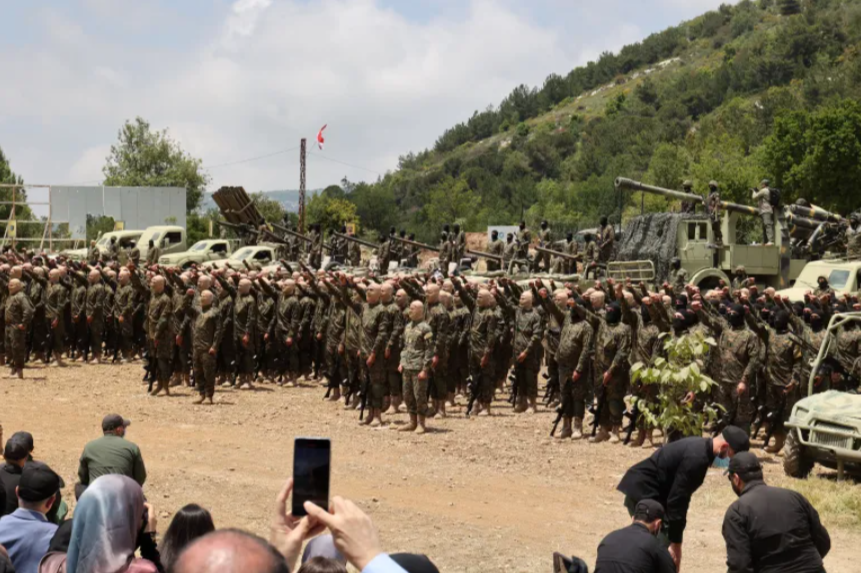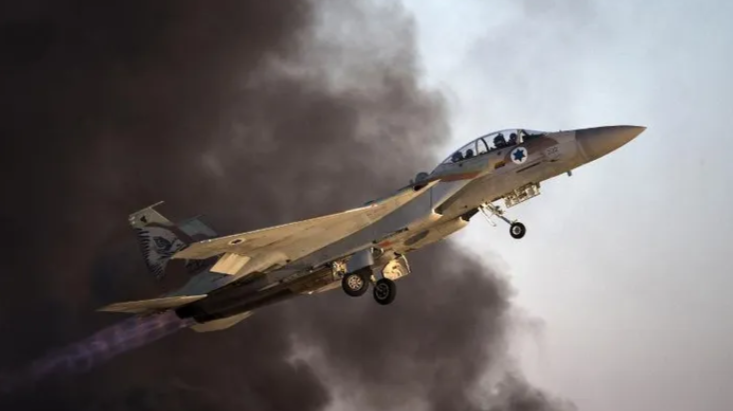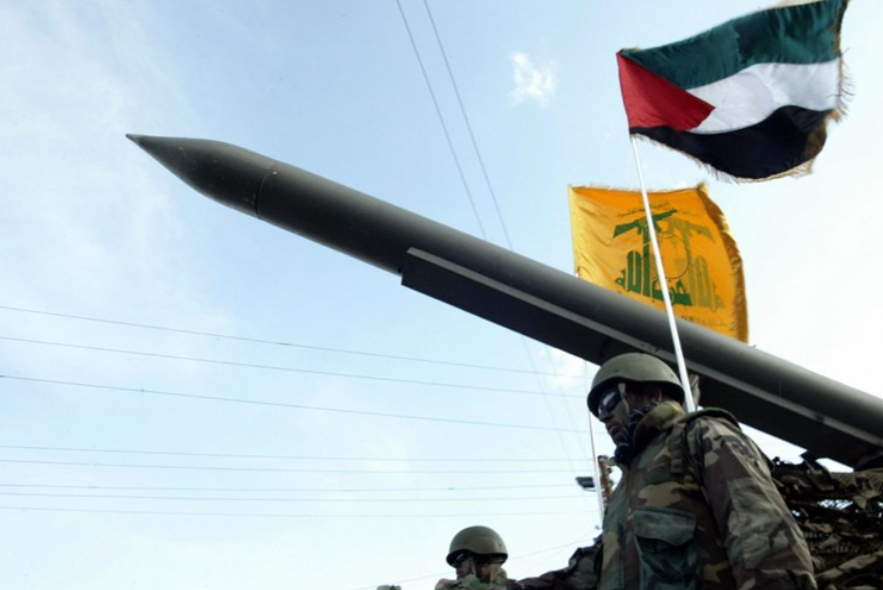
Hezbollah displays a pick-up truck mounted with a multi-rocket launcher in a military parade in the southern Lebanese city of Nabatieh in 2014. (Credit: Mahmoud Zayyat/AFP/File photo)
On June 6, Hezbollah announced that it had fired anti-aircraft missiles at Israeli warplanes, claiming it forced them to retreat. The group has successfully downed several Israeli combat drones since fighting began in October — the latest being on Monday, when it shot a Hermes 900 out of the skies above Mount Rihan with a surface-to-air missile.
But June 6 was the first time its fighters have targeted a jet with such weapons, which raises critical questions: Can Hezbollah actually shoot down Israeli jets and how does this change the conflict?
Since the 2006 war with Israel, Hezbollah has transitioned from a guerrilla force into a well-armed paramilitary organization, significantly enhancing its arsenal. Initially reliant on small arms and basic rockets, the group now boasts a sophisticated array of missiles and anti-aircraft systems.
What does Hezbollah have?
The controversial far-right Israeli research center, Alma, suggested in a report released on May 20 that Hezbollah had acquired Iranian Sayyad-2 surface-to-air missiles, stored in facilities south of Saida. According to Alma, these missiles, derived from American RIM-66 designs, represent a significant upgrade, with the ability to engage targets at ranges up to 100 kilometers and altitudes of 30 kilometers.
On Nov. 2, The Wall Street Journal also reported on Hezbollah potentially acquiring anti-aircraft missiles. According to WSJ, U.S. intelligence believed the Russian state-funded private military Wagner Group planned to transfer a Pantsir-S1 system to the party.
The Pantsir, which NATO calls the SA-22, is a self-propelled anti-aircraft gun and missile system designed for point defense against fixed-wing aircraft, helicopters, cruise missiles, and drones. The Pantsir can operate independently or as part of a battery of up to six launch vehicles.
 Hezbollah fighters parade during a press tour in the southern Lebanese village of Aaramta, on May 21, 2023 (Credit: Anwar Amro/AFP)
Hezbollah fighters parade during a press tour in the southern Lebanese village of Aaramta, on May 21, 2023 (Credit: Anwar Amro/AFP)
Although the exact model of missile used by Hezbollah on June 6 remains unknown, pro-Hezbollah retired Lebanese Army General Amine Hoteit tells L’Orient Today that whatever they used, it’s clear it could hit a low-flying aircraft.
“This missile can hit helicopters and the Israelis know this,” Hoteit says, adding that this could be why the Israeli army rarely uses helicopters in the south.
Retired Lebanese Army General Chamel Roukoz, on the other hand, believes that the missile used by Hezbollah is a new version of the Russian-made SA-6 surface-to-air missile system which he claims Iran bought from Ukraine. Its strength is that its battery — which the Israelis can use to detect the missile launcher — can be activated at the exact moment it fires. “That’s why the Israelis were surprised,” Roukoz said, referring to the fighter jet’s immediate retreat.
“It is possible that Hezbollah has acquired SA-6 air defenses,” says Shaan Shaikh, deputy director of the Missile Defense Project at the Washington-based think tank Center for Strategic and International Studies (CSIS).
“The general's claim that Hezbollah can keep the air defense radar off until they want to use it is true,” he adds. “This is an old tactic that the US and NATO saw used extensively by Yugoslavia in 1999.”
 An Israeli F-15 fighter jet takes off during an air show at the graduation ceremony of Israeli air force pilots at the Hatzerim base in the Negev desert, on June 27, 2013 (Credit: Jack Guez/AFP/File photo)
An Israeli F-15 fighter jet takes off during an air show at the graduation ceremony of Israeli air force pilots at the Hatzerim base in the Negev desert, on June 27, 2013 (Credit: Jack Guez/AFP/File photo)
In his July 2018 report, Shaikh noted that Hezbollah had obtained several sophisticated air defense platforms and that “it's certainly easier to shoot down drones. But Hezbollah's air defenses may also threaten manned aircraft like the F-15” — a hypothesis echoed by Roukoz.
Hezbollah air defenses are less likely to threaten the more expensive F-35 fighter jets, but it’s possible that the Israeli army, whose military strategy is based on air dominance, doesn’t want to take the chance, tending toward the use of unmanned drones instead, Shaikh says.
Deterrence, not destruction
Hoteit suggests that the June 6 missiles may not have been aimed at destroying the aircraft but instead meant to pressure Israeli forces to stop violating Lebanese airspace.
“Until now, Hezbollah is in a support front and not a main war, and in a support front it is taken into consideration that the weapons you’re using are for pressure and not destruction," Hoteit tells L’Orient Today.
When the captain of a warplane knows there are defense systems in place, Hoteit explains, this changes the nature of their operation and prevents certain maneuvers. For example, they might not be able to fly as low as they usually do.
This perspective is corroborated by military expert General Khalil Helou, who says that despite Hezbollah’s capabilities, Israeli aircraft, equipped with advanced missiles like the Delilah, can strike from significant distances, making Hezbollah’s defenses more of an inconvenience to Israeli operations than an actual deterrence.
 Hezbollah fighters participate in the annual military parade in the southern Lebanese city of Nabatieh, displaying Palestinian and party flags and a missile, on Jan. 10, 2009. (Credit: AFP/File photo)
Hezbollah fighters participate in the annual military parade in the southern Lebanese city of Nabatieh, displaying Palestinian and party flags and a missile, on Jan. 10, 2009. (Credit: AFP/File photo)
Hoteit believes that Hezbollah has more advanced weapons in its arsenal that it’s not using now, saving them in case of an escalation — in line with the military rule that a weapon shouldn't be used for an operation unless it's necessary for achieving a specific strategic goal.
Helou is critical of the idea that Hezbollah is selective about which aircraft it chooses to shoot down, suggesting instead that Israel might be provoking Hezbollah to show the locations of their missile systems.
"When these missiles are put into action, a radar guides them, and generally, the system is detected by equipped Israeli jets."
Helou says Hezbollah has improved its use of anti-craft missiles since the war along the border began but not enough to fundamentally alter the military balance.
'Surprises'
A week before Hezbollah first fired toward the Israeli jets, a source close to the party told L'Orient-Le Jour to watch out for the "surprises" that its Secretary General, Hassan Nasrallah, promised Israel in his latest speech. The source said Hezbollah was preparing to use long-range, high-precision weapons, as well as ground-to-air missiles capable of shooting down fighter jets.
"Hezbollah is in no hurry," they said, adding that the surprises could come in the form of newly-introduced weaponry or unexpected operations.